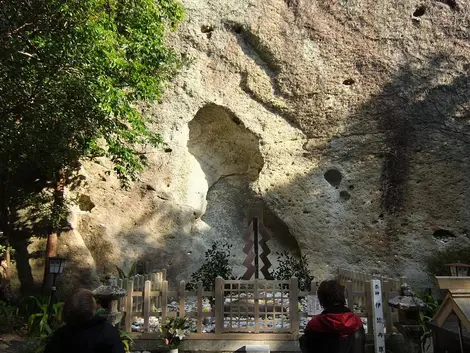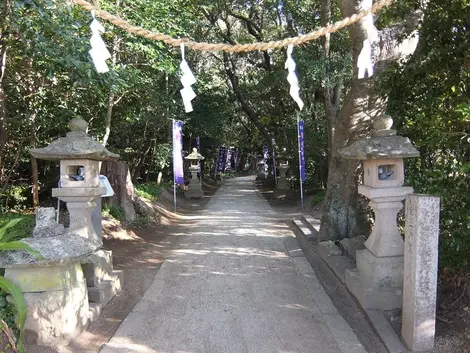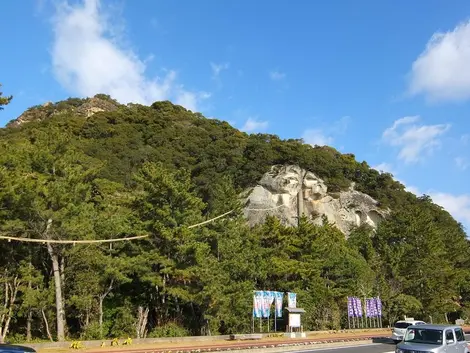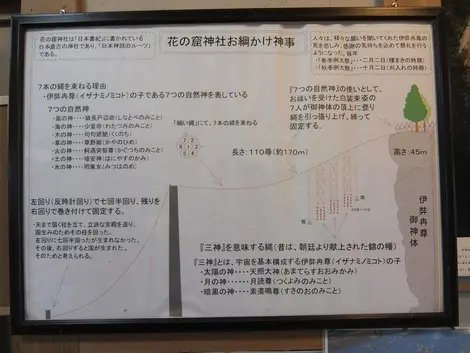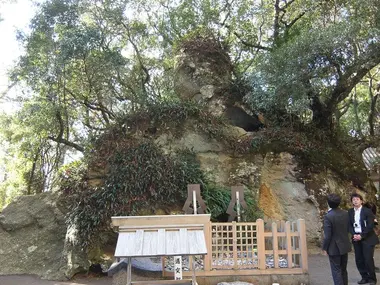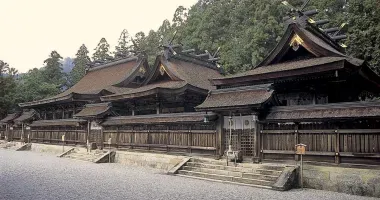Hananoiwaya-jinja in Kumano, Japan's oldest shrine 花の窟神社
- Published on : 27/01/2020
- by : S.V.
- Youtube
Shinto shrine in Mie Prefecture
Since the 8th century, the Hananoiwaya-jinja in Kumano has been recognized as a high place of Japanese cosmogony given the tombs it houses; that of Izanami, the co-creating deity of the world and of the Shinto pantheon and that of his son Kasuguchi, the kami of fire. Listed as a UNESCO World Heritage Site in 2004 as part of the Sacred Sites and Pilgrimage Routes of the Kii Mountain Range, the shrine offers a mystical dive as close as possible to the roots of Shintoism.
A rock as a sanctuary
Qualified as the oldest shrine of the archipelago in the Nihon Shoki or Chronicles of Japan; a collection of myths compiled in 720, the Hananoiwaya-jinja is not a shrine as is commonly understood. Here you can forget about the classic design of the religious complex having a honden or main building in which the spirit of the kami resides.
Indeed, in Hananoiwaya-jinja, for centuries, there was only rock 45 meters high and 80 meters wide instead of a sanctuary. It was only during the Meiji era (1868-1912), so very late given the long history of the place that buildings were built to accompany the sacred rock housing the spirit of the goddess Izanami.
The myth of Izanagi and Izanami
The Nihon Shoki and the Kokiji or Chronicle of Ancient Things dated 712 both relate the legend of the kuniumi, or "birth of the country" as well as the birth of a multitude of kami through the myth of Izanagi and Izanami.
These two deities were charged by the other kami of Heaven to give a solid form to the Earth which until then was empty and shapeless like "a jellyfish floating on the sea". They then created the first island of the archipelago, Onokoro Island, or "first dry land" in the waters of the Seto Inland Sea and then all the other islands of Japan.
From their union on the island of Onokoro will be born several kami including Tsukuyomi, kami of the moon, Amaterasu, kami of the sun and Susanoo, kami of storms then Kagutsuchi, the kami of fire. When the latter is born, Izanami will succumb to his burns.
- Read also: Ise, Meoto Iwa, married rocks
The Flower Cave - Izanami's Tomb
The continuation of the legend of the demiurge couple differs according to the sources. In the Kokiji, Izanagi decides to go find Izanami descended in the Kingdom of the dead called Yomi. But he is horrified to find her monstrously disfigured there. He flees, pursued by the humiliated and furious young woman, and manages to leave Yomi. He then condemns the passage between the world of the living and that of the dead with a huge stone. The latter would also still be visible in Higashizumo southeast of the city of Matsue!
In the texts of the Nihon Shoki, the outcome is quite different. Indeed The Chronicles of Japan relate that Izanami was buried in the town of Arima in Kumano in the cavity of a giant rock block. This tomb would then have been flowered by the inhabitants of the village who came in large numbers to pray Izanami. This cavity 6 meters high, 2.5 meters wide, and 50 cm deep nicknamed the cave of flowers or "hana no iwaya" in Japanese gave its name to the sanctuary; Hananoiwaya-jinja meaning the Flower Cave Shrine.
The Tomb of Kagutsuchi, the Fire Kami
Opposite the tomb of Izanami, sits another divine tomb; that of his son, Kagutsuchi. Here again, the spirit of the kami is embodied in a natural element; a rock 18 meters high. The legend says that after the death of Izanami, Izanagi, mad with pain, would have decapitated and dismembered his son whom he considered responsible for the disappearance of his beloved. Eight gods are said to have been born from his blood and eight others from different parts of his body.
The two tombs, paved with small white stones and surrounded by a fence, see many worshipers pass by daily. Some even indulge in a small mystical ritual consisting of placing a small white stone in one of the cavities of the rock of Izanami hoping to see their wish come true.
The Rope Changing Ritual
Every February 2 and October 2, a unique festival is held at Hananoiwaya-jinja, designated Intangible Cultural Property of Mie Prefecture: the otsunakake shinji or rope-changing ritual.
On this occasion, a rope made from seven intertwined ropes is suspended between the top of the 45-meter rock and a sacred pine (now replaced by a concrete pole) located in the southern corner of the sanctuary enclosure. While only seven officials take on the task at the top of the rock, dozens of people pull the 170-meter-long ceremonial rope on Shichiri Mihama Beach, Japan's longest beach below, to stretch it between the two mounds. then moor it to a concrete block along Route 42.
If the rope withstands the vicissitudes of time and the pangs of the weather, this is a sign of good fortune and abundant harvests. Never a rope that has resisted between the two festivals is removed. The new is put in place alongside the old which will eventually give way on its own.
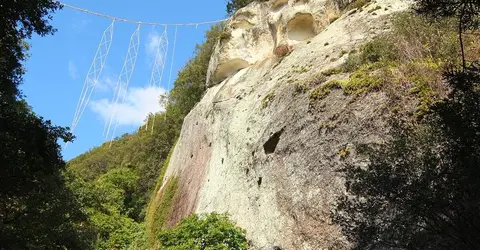
Hananoiwaya-jinja hanging rope
Hideさん
Popular beliefs
If you pay attention to the rope, you will see decorations hanging on it: three braided flags symbolizing the kami Tsukuyomi, Amaterasu and Susanoo.
As for the seven strings that constitute it, they represent seven other kami and children of Izanagi and Izanami : Shinobe, the spirit of the winds; Watatsumi, the god of the oceans; Kukunochi, the deity of trees and forests; Kayanohime, the spirit of herbs; Kagutsuchi, the god of fire; Haniyasu, the earth spirit and Mitsuhanome, the water kami.
Sacred, this ceremonial cord is the subject of several popular beliefs. Thus a pregnant woman who attends the ritual of the rope would be assured of giving birth without any problem . This rope is also credited with healing power . To do this, you would have to pick up one of the decorations that fell on the ground and place it under your pillow or even lick the rope directly...
Address, timetable & access
Address
Phone
0597-89-4111Timetable
From Kumanoshi Station, take the Mie Kotsu bus and get off at Hana-no-Iwaya bus stop (4 min). It is also possible to reach the shrine on foot from Kumanoshi Station (about 15 min).Price
FreeAccess
Open every day





